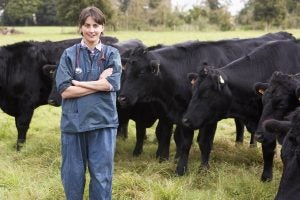Did you know that all meat and dairy products are antibiotic free? If farmers use antibiotics on livestock, by law that animal must go through a withdrawal period to ensure the drug is no longer in their system. This means that by the time it reaches us, there is no antibiotic residues in the finished product. All meat, egg, and dairy products are safe for us, no matter what marketing labels come on a package.
So what’s the deal with all this “antibiotic resistance” hype? Well, it can be very confusing if you try to Google it. Most people don’t have time to read a 100-page study, and most of us are aware that the media sensationalism of people like Dr. Oz is less than honest. To break it down to an easy-to-understand format, I enlisted the help of Dr. Kerry Keffaber, chief veterinarian of scientific affairs at Elanco Animal Health.
Keffaber clarifies a common misconception: “It’s important to understand there’s a difference between residue and resistance. It’s not the residue that is the focus (there is no residue of concern thanks to withdrawal times), it’s the resistance that can develop.”
When an animal gets sick, as farmers we need to treat it. But while treating one thing, there could be something else going on internally that we are not aware of. What if we are treating something respiratory but there’s bacterial issues in the animal’s GI tract? When we use an antibiotic, we can select for those strains of bacteria that are resistant to the antibiotic, but what if the bacteria survive anyway? What if antibiotics have been overused or the bacteria spread to other animals?
The good news is that every meat packing plant goes through extensive steps of food safety testing and risk control processes to protect from bacteria transfer — whether it is resistant to an antibiotic or not. Every animal is inspected before and during harvest, following strict process protocols, samples, data collection, risk monitoring, compliance, grading, etc.
The chances of spreading a resistant bacteria from an animal to human are extremely slim, but the chance is not zero. Keffaber said that there are four steps that would need to happen for antibiotic resistance from animals to affect humans:
- Resistance has to develop within the animal.
- The resistant bacteria needs to be transferred within the equipment of a slaughterhouse.
- A person has to be exposed to the bacteria (even after the cooking process!) and become ill.
- The person has to receive antibiotics from a doctor and have them not be effective.
At the moment, over 95 percent of the bacteria of resistance concern related to animal use of antibiotics still respond to the first antibiotic choice from their doctor. But it would be wrong to ignore this risk, and that is why the FDA has cracked down on antibiotic usage.
The initial focus of the FDA is that by the end of this year (2016) all medically important antibiotics (ones that are permitted in humans and livestock) for growth promoting will no longer be allowed and will only be available with a veterinarian prescription. No more growth promotion use of these antibiotics in feed and water. Tighter regulations. Done.

So what does this mean? Farmers will have to work closer with their veterinarians. As a sheep and beef cattle farmer myself, I am all for this. No matter what a marketing labels says, I think it’s fair to say that animal care is a top priority for any farmer, since it is our business and our livelihood. Happy, healthy animals lead to more production, less stress, and less antibiotic usage, which means spending less money. Antibiotics are an important tool in the toolbox, but not the only thing, and we must use them responsibly.
Animal health is still very important obviously, so the tides are changing a little more toward preventive care. Vaccine innovation will play a key role to producing enough food to feed 9 billion people while using less resources. I don’t know about you, but I would much rather vaccinate against common diseases than wait until it is too late — at which point you’ve got a bigger mess with more expense and disease on your hands. No one wants to see an animal sick.
Keffaber adds, “Antibiotic resistance in humans driven by use of antibiotics in animals is very unlikely, but it isn’t zero. Ignoring the problem isn’t right. We still need to use antibiotics, but let’s do it responsibly.”



